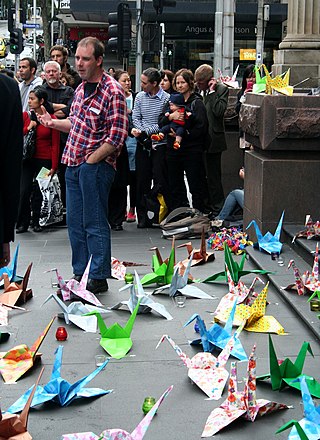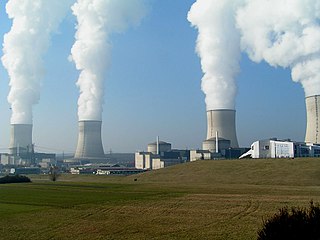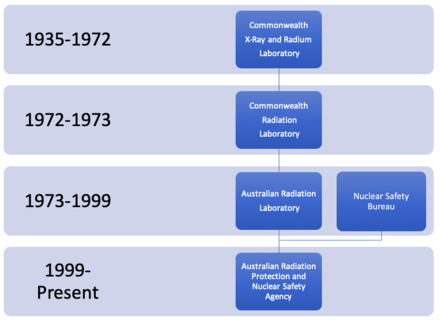
Nuclear fallout is the residual radioactive material propelled into the upper atmosphere following a nuclear blast, so called because it "falls out" of the sky after the explosion and the shock wave has passed. It commonly refers to the radioactive dust and ash created when a nuclear weapon explodes. The amount and spread of fallout is a product of the size of the weapon and the altitude at which it is detonated. Fallout may get entrained with the products of a pyrocumulus cloud and fall as black rain. This radioactive dust, usually consisting of fission products mixed with bystanding atoms that are neutron-activated by exposure, is a form of radioactive contamination.
Ionizing radiation, including nuclear radiation, consists of subatomic particles or electromagnetic waves that have sufficient energy to ionize atoms or molecules by detaching electrons from them. Some particles can travel up to 99% of the speed of light, and the electromagnetic waves are on the high-energy portion of the electromagnetic spectrum.
Medical physics deals with the application of the concepts and methods of physics to the prevention, diagnosis and treatment of human diseases with a specific goal of improving human health and well-being. Since 2008, medical physics has been included as a health profession according to International Standard Classification of Occupation of the International Labour Organization.

A nuclear and radiation accident is defined by the International Atomic Energy Agency (IAEA) as "an event that has led to significant consequences to people, the environment or the facility. Examples include lethal effects to individuals, large radioactivity release to the environment, reactor core melt." The prime example of a "major nuclear accident" is one in which a reactor core is damaged and significant amounts of radioactive isotopes are released, such as in the Chernobyl disaster in 1986 and Fukushima nuclear disaster in 2011.

Health physics, also referred to as the science of radiation protection, is the profession devoted to protecting people and their environment from potential radiation hazards, while making it possible to enjoy the beneficial uses of radiation. Health physicists normally require a four-year bachelor’s degree and qualifying experience that demonstrates a professional knowledge of the theory and application of radiation protection principles and closely related sciences. Health physicists principally work at facilities where radionuclides or other sources of ionizing radiation are used or produced; these include research, industry, education, medical facilities, nuclear power, military, environmental protection, enforcement of government regulations, and decontamination and decommissioning—the combination of education and experience for health physicists depends on the specific field in which the health physicist is engaged.

The antennas contained in mobile phones, including smartphones, emit radiofrequency (RF) radiation ; the parts of the head or body nearest to the antenna can absorb this energy and convert it to heat. Since at least the 1990s, scientists have researched whether the now-ubiquitous radiation associated with mobile phone antennas or cell phone towers is affecting human health. Mobile phone networks use various bands of RF radiation, some of which overlap with the microwave range. Other digital wireless systems, such as data communication networks, produce similar radiation.

The Open-pool Australian lightwater reactor (OPAL) is a 20 megawatt (MW) swimming pool nuclear research reactor. Officially opened in April 2007, it replaced the High Flux Australian Reactor as Australia's only nuclear reactor, and is located at the Australian Nuclear Science and Technology Organisation (ANSTO) Research Establishment in Lucas Heights, New South Wales, a suburb of Sydney. Both OPAL and its predecessor have been commonly known simply as the Lucas Heights reactor.

Oyster Creek Nuclear Power Station was a single unit 636 MWe boiling water reactor power plant in the United States. The plant is located on an 800-acre (3.2 km2) site adjacent to Oyster Creek in the Forked River section of Lacey Township in Ocean County, New Jersey. At the time of its closure, the facility was owned by Exelon Corporation and, along with unit 1 at Nine Mile Point Nuclear Generating Station, was the oldest operating commercial nuclear power plant in the United States. The plant first started commercial operation on December 23, 1969, and is licensed to operate until April 9, 2029, but Oyster Creek was permanently shut down in September 2018. The plant got its cooling water from Barnegat Bay, a brackish estuary that empties into the Atlantic Ocean through the Barnegat Inlet.
The Australian Nuclear Science and Technology Organisation (ANSTO) is a statutory body of the Australian government, formed in 1987 to replace the Australian Atomic Energy Commission. Its head office and main facilities are in southern outskirts of Sydney at Lucas Heights, in the Sutherland Shire.

Nuclear safety is defined by the International Atomic Energy Agency (IAEA) as "The achievement of proper operating conditions, prevention of accidents or mitigation of accident consequences, resulting in protection of workers, the public and the environment from undue radiation hazards". The IAEA defines nuclear security as "The prevention and detection of and response to, theft, sabotage, unauthorized access, illegal transfer or other malicious acts involving nuclear materials, other radioactive substances or their associated facilities".

The Pakistan Nuclear Regulatory Authorityپاکستان نیوکلیئر ریگولیٹری اتھارٹى; (PNRA), is mandated by the Government of Pakistan to regulate the use of nuclear energy, radioactive sources and ionizing radiation. The mission of PNRA is to protect the public, radiation workers and environment from the harmful effects of ionizing radiation by formulating and implementing effective regulations, building a relationship of trust with licensees, and maintaining transparency in its actions and decisions.
The Ionising Radiations Regulations (IRR) are statutory instruments which form the main legal requirements for the use and control of ionising radiation in the United Kingdom. There have been several versions of the regulations, the current legislation was introduced in 2017 (IRR17), repealing the 1999 regulations and implementing the 2013/59/Euratom European Union directive.
The International Commission on Radiological Protection (ICRP) is an independent, international, non-governmental organization, with the mission to protect people, animals, and the environment from the harmful effects of ionising radiation. Its recommendations form the basis of radiological protection policy, regulations, guidelines and practice worldwide.

The Atomic Energy Regulatory Board (AERB) was constituted on 15 November 1983 by the President of India by exercising the powers conferred by Section 27 of the Atomic Energy Act, 1962 to carry out certain regulatory and safety functions under the Act. The regulatory authority of AERB is derived from the rules and notifications promulgated under the Atomic Energy Act, 1962 and the Environmental (Protection) Act, 1986. The headquarters is in Mumbai.

Jim Green is an anti-nuclear campaigner with Friends of the Earth Australia. Green is a regular media commentator on nuclear issues. He has an honours degree in public health from the University of Wollongong and was awarded a PhD in science and technology studies for his analysis of the Lucas Heights research reactor debates.
A wipe test counter is a device used to measure for possible radioactive contamination in a variety of environments. When using radioactive materials it is necessary to test for accidental contamination, whether from use of liquid unsealed sources or to check for leaking sealed sources. A swab or small absorbent smear can be used to “wipe” an area, the wipe is then placed into a test tube and counted, typically using a gamma counter. Testing for leaks in this manner is a method described in the ISO 9978 standard.

Nuclear labor issues exist within the international nuclear power industry and the nuclear weapons production sector worldwide, impacting upon the lives and health of laborers, itinerant workers and their families.

Tony Irwin is a nuclear engineer and technical director of Australian company, SMR Nuclear Technology. For three decades he worked commissioning and operating nuclear reactors in the UK for British Energy. He emigrated to Australia in 1999 and took a position with the Australian Nuclear Science and Technology Organisation (ANSTO), where he remained for ten years. Irwin chairs the Nuclear Engineering Panel of Engineers Australia and lectures at the Australian National University and University of Sydney on nuclear science. Irwin has a degree in electrical power engineering.

Nuclear power plants pose high risk if chemicals are exposed to those in surrounding communities and areas. This nuclear emergency level classificationresponse system was firstly developed by the US Nuclear Regulatory Commission to allow effective and urgent responses to ultimately control and minimise any detrimental effects that nuclear chemicals can have. These classifications come in four different categories – Unusual Event, Alert, Site Area Emergency (SAE), as well as General Emergency. Thus, each classification has differing characteristics and purposes, depending on the situation at hand. Every nuclear power plant has a different emergency response action plan, also depending on its structure, location and nature. They were developed by thorough discussion and planning with numerous authoritative parties such as local, state, federal agencies as well as other private and non-profit groups that are in association with emergency services. Today, nuclear emergency plans are continuously being developed over time to be improved for future serious events to keep communities and nuclear power plant working members safe. There is a high emphasis for the need of these emergency responses in case of future events. Thus, nuclear plants can, and have paid up to approximately $78 million to ensure that are required measurements are readily available, and that equipment is sufficient and safe. This is applicable for all nuclear power plants in the United States of America.
Michael Harry Repacholi is an Australian biophysicist and radiation protection expert. He is one of the pioneer scientists and foremost authorities in Radiobiology in the world, including radiation protection standards for ionizing radiation and non-ionizing radiation across the electromagnetic spectrum. He was one of the founders and past presidents of the International Commission on Non-Ionizing Radiation Protection (ICNIRP) and founder and director of several projects in the World Health Organization, including the International Electromagnetic Fields (EMF) Project. Repacholi was also active in the study of the health consequences of the Chernobyl accident in the nuclear reactor, in Ukraine.

















